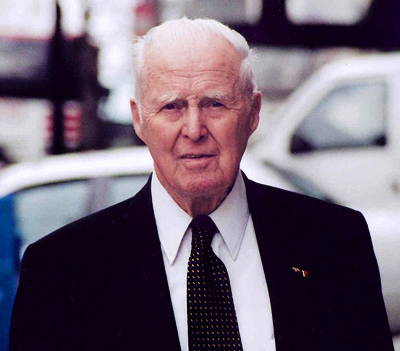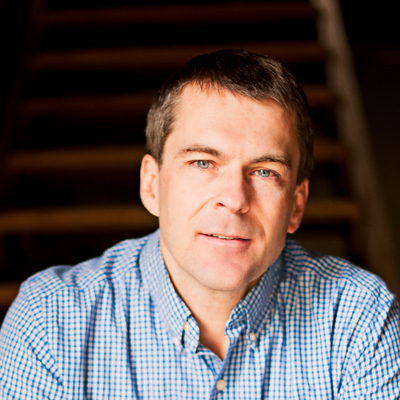
He is commonly credited with saving as many as a billion lives. By one expert’s calculation, about half the world’s population sleeps better each night for having consumed grain descended from one of the varieties he helped develop. His biographer called him The Man Who Fed the World, and he was one of only five persons ever to receive the Presidential Medal of Freedom, the Congressional Gold Medal, and the Nobel Peace Prize. Yet most Americans have never heard of him.
“In the middle of the 20th century,” Bill Gates recently said at the World Food Prize Symposium, “experts predicted famine and starvation, but they turned out to be wrong—because they did not predict Norman Borlaug.”
Borlaug, who died in September at the age of 95, was born in rural Cresco, Iowa. His early life is the stuff of storybooks—born in the family farmhouse, educated in a one-room schoolhouse, and remembered for whistling aloud as he milked the cows. Although he initially failed the entrance exam to the University of Minnesota, he was not easily deterred from his goals. He eventually worked his way through college, including a stint as a Civilian Conservation Corps leader. He witnessed hunger during the Depression, and it left an indelible impression on him.
After taking a doctorate in plant pathology, Borlaug secured a promising post with DuPont in 1942. Just two years later, however, he walked away from it, despite an offer to double his salary. He moved to Mexico in order to head up a new research project designed to improve wheat production amidst food shortages.
Increase production he did, but not before encountering obstacles of every imaginable kind. Not only were the crops diseased and the soil depleted, but the sun was hot and research funds limited. More discouragingly still, he encountered resistance to his ideas among both local farmers and his supervisor, leading him at one point to resign (only to be reinstated by a superior). According to the New York Times, Borlaug “battled illness, forded rivers in flood, dodged mudslides and sometimes slept in tents.” Still, he remained in Mexico for 16 years.
Borlaug helped innovate new techniques, including the selective breeding of wheat to resist a fungus called rust, and “shuttle breeding.” Challenging conventional wisdom, Borlaug tested varieties in diverse climates by transporting or “shuttling” them across great distances, which simultaneously increased the breeding cycles per year and generated crops that were adapted to a wider range of conditions.
Perhaps Borlaug’s greatest contribution to food production was “dwarfing”—crossbreeding that resulted in shorter, sturdier plants that could support high yields. The results were breathtaking. Within a few years, production per acre increased by a factor of three to four; fifteen years after his arrival, wheat production in Mexico had increased sixfold; eventually, Mexico began exporting wheat.
Although by 1960 his credentials already would have ranked him among the world’s great humanitarians had he chosen to retire, this was Norman Borlaug, and he was just getting started. In the 1960s, when India and Pakistan had a food crisis, they contacted Borlaug, who attempted to deliver 35 truckloads of wheat seeds from Mexico. Again the obstacles were great. Not least of all, Borlaug arrived to find India and Pakistan—his hosts—at war. With artillery flashes literally lighting the sky over their shoulders, Borlaug and his Mexican assistants began sowing the soil with seeds. The image illustrates Borlaug’s conviction that prosperity is a prerequisite of peace. Stunningly, Pakistan was self-sufficient in three years, and India in six.
Curiously, Borlaug’s work was controversial. Some environmentalists were critical of his use of fertilizer, pesticides, and even tractors. “If [Western environmentalists] lived just one month amid the misery of the developing world,” Borlaug responded, “as I have for 50 years, they’d be crying out for tractors and fertilizer and irrigation canals and be outraged that fashionable elitists in wealthy nations were trying to deny them these things.” As Gregg Easterbrook points out in his remembrance of Borlaug, the irony of these criticisms is that high-yield agriculture has preserved forests that otherwise almost certainly would have been converted to pasture, and slowed population growth as education became valued more highly than muscle power.
To be sure, much work remains in balancing food production with conservation, and with food security in general, especially in Africa. In Africa as elsewhere, however, today’s research builds on that of Borlaug. His techniques have been applied to other grains, such as rice, and other nations, including China. Bill Gates, co-chair of the largest foundation in the world, specifically attributes his interest in agricultural development to the successes of the “Green Revolution.”
The details of Borlaug’s life have been made more widely known in articles on the front page of the New York Times and elsewhere in recent weeks. For all the light they shine on Borlaug’s distinguished career, however, most of these articles shed little light on the man.
Most of the reportage on Borlaug entails what the reporters at GetReligion.org (motto: “The press just doesn’t get religion”) call a “holy ghost”—a story about religion that remains invisible. The New York Times article, for example, despite running 2200 words, including mention of “stalwart community of Norwegian immigrants,” nowhere mentions the word “Lutheran.”
As GetReligion.org puts it, the Times “failed to address the big Why question, leaving readers wondering what motivated Borlaug’s lifelong crusade to combat hunger and famine by increasing food production.” After all, moving to Mexico wasn’t exactly a career move.
According to Rev. David Beckman, President of Bread for the World, Borlaug was “a man of faith and compassion . . . an advocate as well as a scientist.” Indeed, Borlaug was one of the first trustees of Bread for the World (motto: “Have faith. End hunger.”)
For an answer to the big Why question, one need look no further than Borlaug’s Nobel Prize acceptance speech. “The recognition that hunger and social strife are linked is not new,” Borlaug said, “for it is evidenced by the Old Testament passage ‘and it shall come to pass, that when they shall be hungry, they shall fret themselves, and curse their King and their God.’” Modern scientific and technological skills, he added, may help “Isaiah’s prophesies come true: ‘And the desert shall rejoice, and blossom as the rose… And the parched ground shall become a pool, and the thirsty land springs of water.’”
Easterbrook calls Borlaug a hero—someone “who can provide [a constructive example] to the young.” Although Borlaug surely had aptitudes that many of us do not, in most respects—his self-sacrifice, his determination in the face of failure, and his willingness to live and labor among the poor—he made vivid virtues that can in fact be imitated by most mere mortals. In Asia, Africa, and the Americas, his modus operandi was the same: he saw a need, addressed it with his time and talents, and never gave up.
That Borlaug remains an unfamiliar name to most Americans is unfortunate, but not necessarily surprising. Arguably, there has never been a time and place in history that appreciates the headline: “Remarkable man forsakes lifestyle of rich and famous to serve the poor; dies in relative obscurity.”
This article appeared in the November 2009 edition of The Herald Examiner.


